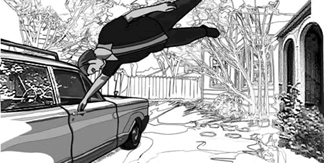Kaleidoscopic Dreams
Linklater's Entrancing 'Waking Life' Is An Instant Cult Classic
By Patrick Reed

Wiley Wiggins tries to hang onto his consciousness.
Released nationwide last autumn, Richard Linklater's Waking Life has snaked across the indie-film circuit over the past several months, engendering strong word-of-mouth among college crowds, midnight-film maniacs, and lovers of innovative animation. For over a decade, the writer-director has defined an aesthetic that has been too often entwined with the now (and always) lifeless "Generation X" stereotype. Sure, a surface thread can be traced from Slacker (1991) and Dazed and Confused (1993) on through Before Sunrise (1995) and SubUrbia (1997, adapted from Eric Bogosian's play) - all focus on teenagers/young adults, who mainly stand around and talk, probing the conundrums of life - but even within this general framework, each film is unique. Linklater's stories are unpredictable, and his characters are consistently surprising, often spouting dialogue rich with ideas and (bravely, in this video-game-addled zeitgeist) unafraid to sacrifice action for thoughtfulness. Far from some sort of passé nineties wonder boy, Linklater's track record instead reveals the Austin, Texas native as - film-snob alert! - a modern-day auteur of sorts. Waking Life once again features Linklater's inquisitive mind and ear for intelligent discourse, fusing them with absolutely dazzling visuals to create, if such a seemingly contradictory designation is possible, an instant cult-classic.
Waking Life's website fills in the story behind the film's groundbreaking animation technique; Linklater shot the film on low-budget digital video (as he did with his other fall '01 release, Tape) and then assigned a diverse cast of animators to individually interpret each of the film's many vignettes. Under the command of animation director Bob Sabiston, the art was then painted over the digital footage via computer through a "rotoscoping" process. Several bold touchstones in 20th-century animation are recalled at one point or another: Yellow Submarine (1968), Ralph Bakshi, John and Faith Hubley, MTV's Liquid Television, etc. Far be it from me to suggest that a virgin viewing of Waking Life should be accompanied by hallucinogens; on the contrary, so entrancing is this film's visionary punch that a person girded with John Ashcroft's temperance level will still walk out of the theater a convert, googly-eyed and mind-blown.
As for the plot imagine watching Slacker through a kaleidoscope lens, and you're on the right track. In other words, what plot? And who cares!? Waking Life follows a nameless young wanderer (Dazed and Confused's Wiley Wiggins) around Austin (with a brief detour to NYC) as he trespasses the evermore-meaningless boundary between his dreams and corporeal self. The movie begins with the mantra "dream is destiny" and then blooms into a dizzying series of encounters - some bizarre, very few boring, and nearly all of them abundant with big ideas. Wiggins crosses paths with many interesting people - he eavesdrops, asks for advice, absorbs - and there is a constant, enveloping doubt about whether he is dreaming or awake and whether it matters. The name-dropping and theory-wrangling are enough to make you regret all the time spent daydreaming through undergrad: Sartre/existentialism, Timothy Leary/reincarnation (discussed by Julie Delpy and Ethan Hawke, the lovers from Before Sunrise reunited), André Bazin's cinema theory, Debord/situationism and countless other citations (several professors from the Austin area are on hand to offer sagacity, and look for an amusing Steven Soderbergh cameo as Wiggins channel-surfs).
This is the type of film that will reveal different impulses and motivations from within each viewer; some interludes will pass by without much impact, and others may very well astound. On my list: a bald, beer-gutted demon of a man (Charles Gunning) bellows a hateful, graphically violent rant against his accusers from inside a dark jail cell a lisping, vivacious frizzy-haired bohemian (Timothy "Speed" Levitch, the true-life oddball Manhattan tour-bus guide in 1998's The Cruise) spills his devotion to the examined life at hummingbird speed and an aged professor (Louis Mackey), sits at a bar and gravely asks a question to end all discussion of mankind's worth: "Which is the most universal human characteristic: fear or laziness?"
Wiggins never reaches a moment of clarity, affirming Waking Life's central message that the line separating our dreams and reality is tissue-thin, and ever-shifting. Near the end, in a bar, Wiggins encounters Linklater himself, playing pinball and trying to make sense of a dream he had about Philip K. Dick, dogs and death. Linklater's conclusion that our everyday "waking life" is but humankind's way of staving off "the acceptance of God," - i.e., the acceptance of death - posits an intriguing final argument: that we are in effect previewing the afterlife every time we dream. Rarely has there been a picture that combines such an array of penetrating ideas with a perfectly calm, lucid and transfixing treatment - Waking Life plays like the best dream you ever had.